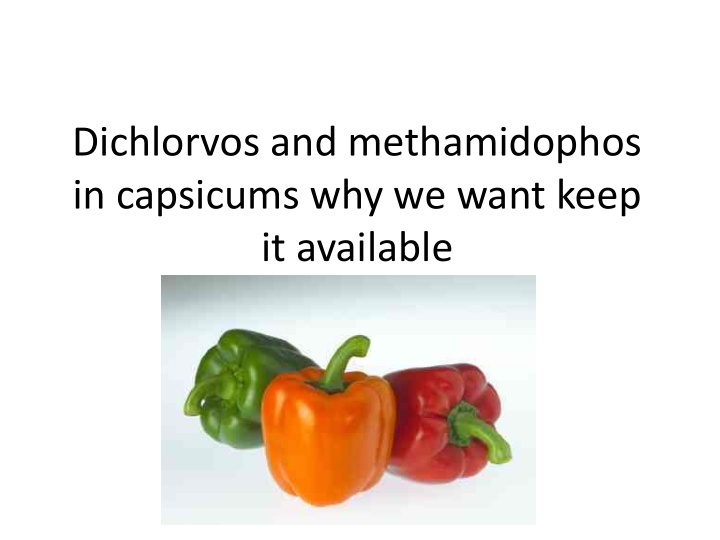



Dichlorvos and methamidophos in capsicums why we want keep it available
Capsicum acreage greenhouses • Total New Zealand 55 ha • Two main growers/exporters, Southern Paprika and NZ Gourmet 41 ha • Both companies producing in different countries • Working in a growth market both companies expanded last year and this year • Export 60 – 70% mainly Japan export value about 20 - 25 million. • Employing over 200 staff
Insect control • Residue is a big issue in export market especially Japan • For this as much Integrated Pest Management as possible • Clean start of a new crop and use of two predators Phytoseiulus persimilis and Cucumeris barkeri
IPM • Clean start essential • Introduction of predators at propagation • Weekly introductions of predators • In case of small insect infestations, spot sprays abamectine/milbemectine/Success or Oberon (Psyllid) • Large infestations dichlorvos (summer conditions) • Clean out after last pick with methamidophos
Advantage dichlorvos • Limited side effect on predators • No negative effect of residue on leaves for introduction of predators next day following a treatment • Strong vapour effect and good efficacy • Low residue levels on fruit, as a grower we test samples for residue on a monthly basis, never found residues above MRL
Application technique • Pulse foggers, semi automated equipment vapourising the chemical • Limited number of rows treated in full grown crop for young crop treating an area up to 1.5 ha at a time (automated) • Foggers filled/loaded in controlled area • Using foggers means less active used compared to spraying • Some growers use LVM but too small to use on large area’s 1500 m2 per unit
Staff Protection • Staff fully protected, full PPE covering suits, full mask and earmuffs • Greenhouse completely closed until chemical has settled down • Ventilation before staff goes back in the house minimal 30 minutes all vents open • Treatments usually done on a Friday or Saturday Check before staff enters after the weekend • Staff applying chemicals regularly have cholinesterase tests, never results very good no negative effects found
Emissions from greenhouse • Dichlorvos has negative effect on aquatic life • Greenhouses are a closed environment – All drain from substrates/floors are collected and re- used in irrigation no leaching – Vents are closed after treatment until product has settled down – Active can contaminate condense on the glass, all condense is collected by means of a condense gutter and this water goes into the irrigation supply where chemicals can break down
Predators used
Foggers
Fogging
LVM
Condense gutter
Summary • Dichlorvos is essential in running an IPM program and avoiding or keeping residue’s as low as possible • Low residue on crop and fruit • Safe way of application • No emission from greenhouses • Loss of Dichlorvos will mean IPM program will be shorter and more less effective chemicals will be used • IPM means no risk off resistance so “soft” chemicals will be more effective
Recommend
More recommend